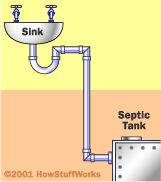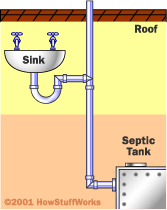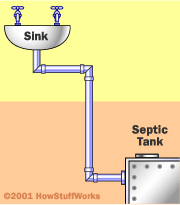Plumbing
Let's say you want to put a toilet in a house. Two-hundred or 300 years ago this was not an option -- everyone used outhouses. If you visit the governor's mansion in Williamsburg, VA, you will see that in the 1700s even England's high colonial governor used a pair of three-holer outhouses located at the back of the formal garden. Eventually, public water supplies and pressurized well systems allowed people to have indoor plumbing, and this allowed for the addition of indoor toilets. A toilet has to flush somewhere, so sewer systems evolved.
Why can't you run the sewer line from a toilet or a sink out of the side of the house so it spills on the ground? That certainly would be easy and inexpensive, but people learned fairly quickly that human waste spilled on the ground smells bad and leads to incredible disease problems. Septic tanks and sewer systems take care of this. The uniform plumbing code lists hundreds of rules for septic-tank installation. These rules ensure that tanks work properly over many years.
Advertisement
Once you have a septic tank in place, you can add sewer lines from the sink or toilet to the septic tank. Say you tried this approach:
The problem with this approach is that as the septic tank fills up with stuff, it produces a rather malodorous cloud of fumes. These fumes float from the septic tank up the sewer line to the sink and into the bathroom. Therefore, plumbing codes require a "P-trap" at every drain opening, as shown here:

You may have wondered why you find these funny loops of pipe under every sink in your house. The idea is that water gets trapped in the "P." This water blocks the fumes from the septic tank and keeps them from entering the bathroom. Unfortunately, a P-trap alone does not solve the problem because it turns out that the fumes in a septic tank are under pressure. The fumes simply bubble through the water in the trap and cause the same problem. Therefore, there is the concept of a vent pipe, which allows the pressure to escape, as shown here:

You may have wondered why houses have pipes sticking up out of the roof. They are vent pipes to relieve the pressure so that P-traps can do their jobs. It turns out that vents also break vacuums so water flows down the pipes faster.
Besides covering P-traps and vent pipes, the uniform plumbing code specifies all sorts of other things:
- The required diameters for pipes
- The allowed materials for pipes
- The types of joints you can use
- The necessary supports for pipes
- The angle at which pipes must fall
- The longest distance for lateral pipes
- And on and on and on through hundreds of pages
When plumbers follow all the rules, they are able to create extremely reliable and safe plumbing systems. Over time, new rules get added as people realize funny little quirks and nuances. These new rules prevent problems in the future, and each one makes the code a little bigger and better.
This is all a nice way to say that, even though plumbing looks simple in this section, there are many subtleties and nuances dictated by code that plumbers know and neophytes generally do not. (The same holds true for electrical systems, by the way.)
